Tulsi: The Queen of Herbs
Nourishing native pollinators, bringing peace to the mind, beauty to the garden and healing to the body... She is a herb without an equal.
This was my favorite crop from our garden in 2021 and is now among my top 5 favorite garden crops of all time. It smells great, it tastes amazing, it heals the body, mind and nourishes the local pollinators.
Here is some info on the health benefits of Holy Basils (aka “Tulsi”)
All species of basil offer anti-inflammatory, antioxidant, and digestion- and cognition-enhancing properties but holy basil takes it several steps further than common garden basils. Holy basil’s clove- and mint-like fragrance pulls people into a relaxing, Zen state. Most famously, Tulsi acts as an adaptogenic herb, helping the body adapt to stress and find deep reserves of energy. Holy basil is said to be one of the easiest of all adaptogens to grow and harvest in abundance, and its ability to both calm, detoxify, heal and energize makes it a must have in the kitchen and ‘natural first aid kit’.
Tulsi is an aromatic shrub in the basil family Lamiaceae (tribe ocimeae) that is thought to have originated in north central India and now grows native throughout the eastern world tropics. Tropical types (Krishna, Vana, Amrita) are best started in strong light in warm conditions. The temperate tulsi will germinate on a windowsill. Regarding the temperate tulsi (previously misnomered “Kapoor”), the owners of Strictly Medicinal Seeds tested this cultivar and confirmed the eugenol marker, and subsequent genetic testing shows it to be a basil of African origin–Ocimum africanum.
Within Ayurveda, tulsi is known as “The Incomparable One,” “Mother Medicine of Nature” and “The Queen of Herbs,” and is revered as an “elixir of life” that is without equal for both its medicinal and spiritual properties.
The medicinal properties of tulsi have been studied in hundreds of scientific studies (including animal and human experiments). These studies reveal that tulsi has a unique combination of actions that include: Antimicrobial (including antibacterial, antiviral, antifungal, antiprotozoal, antimalarial, anthelmintic), mosquito repellent, anti-diarrheal, anti-oxidant, anti-cataract, anti-inflammatory, chemopreventive, radioprotective, hepato-protective, neuro-protective, cardio-protective, anti-diabetic, anti-hypercholesterolemia, anti-hypertensive, anti-carcinogenic, analgesic, anti-pyretic, anti-allergic, immunomodulatory, central nervous system depressant, memory enhancement, anti-asthmatic, anti-tussive, diaphoretic, anti-thyroid, anti-ulcer, anti-emetic, anti-spasmodic, anti-arthritic, adaptogenic, anti-stress, anti-cataract, anti-leukodermal and anti-coagulant activities. These pharmacological actions help the body and mind cope with a wide range of chemical, physical, infectious and emotional stresses and restore physiological and psychological function.
For additional information on the medicinal benefits of Tusli: https://www.ncbi.nlm.nih.gov/pmc/articles/PMC4296439/ and https://timesofindia.indiatimes.com/city/patna/tulsi-can-extend-human-lifespan-says-pu-research/articleshow/71038896.cms
The nutritional value is also high, as it contains:
-vitamin A and C
-calcium
-zinc
-iron
-chlorophyll
-phosphorous
-potassium
-magnesium
and more
It also contains other well studied medicinal compounds such as:
-Eugenol,
-Oleanolic acid
-Ursolic acid
-Rosmarinic acid
-Carvacrol
-Linalool
-β-caryophyllene
Holy basil is also high in antioxidants and helps your body detox. Studies show that holy basil can protect your body against toxic chemicals.
Tulsi Also Contains Compounds Which Optimize Mitochondrial Health:
Mitochondria are the powerhouses of your cells, generating energy to fuel your cells’ biochemical reactions. Via optimizing their function and promoting their rates of regeneration within your body you are building a solid foundation for health, vibrancy and longevity from the cellular level up.
Sufficient mitochondrial biogenesis (the process by which cells increase mitochondrial numbers) is necessary for efficient cell function and haemostasis, which is dependent on the regulation of ATP generation and maintenance of mitochondrial DNA (mtDNA). These procedures play a primary role in the processes of inflammation, detox, aging, cancer, metabolic diseases, and neurodegeneration.
Antioxidants such as Polyphenols (anthocyanins being one example, which are contained in purple leaved Tulsi varieties such as “Krishna Tulsi) are considered as the main components of plants, fruits, and natural extracts with proven therapeutic effects relating to Mitochondrial Health. These components regulate the intracellular pathways of mitochondrial biogenesis.
Additionally, research showed that Tulsi extract ameliorates adipocyte lipid accumulation and enhances mitochondrial fatty acid oxidation via PPARγC1α, PRDM16 and UCP-1. Enhanced adipocyte fatty acid oxidation diminishes adipocyte hyperplasia, via downregulation of C/EBPα and PPARγ genes.
It also prevents cancer by reducing the growth of cancerous cells.
Tuli protects against infection and treat wounds:
Extracts made from its leaves are thought to boost wound healing speed and strength. Holy basil is:
-antibacterial
-antiviral
-antifungal
-anti-inflammatory
-analgesic (a painkiller)
Some people even use holy basil after surgery to heal and protect their wounds. Holy basil increases your wound’s breaking strength, healing time, and contraction. Breaking strength refers to how much pressure or weight a wound can take before it breaks.
— Reduces stress and anxiety:
All parts of the holy basil plant act as an adaptogen. An adaptogen is a natural substance that helps your body adapt to stress and promotes mental balance.
The concept of an adaptogen is a holistic approach. But scientific research shows that holy basil has pharmacological properties to help your mind cope with many types of stress.
The source of your stress can be:
-chemical
-physical
-infectious
-emotional
In the case of physical stress, holy basil is known to increase endurance in animals. Animals who had holy basil leaf extracts and went through environment-induced stress scenarios showed:
-enhanced metabolism
-improved swimming time
-less tissue damage
-lower stress levels in loud environments
Human and animal studies saw reduced:
-stress
-endurance problems
-sleep problems
-forgetfulness
-exhaustion
According to the Journal of Ayurveda and Integrative Medicine, holy basil has antidepressant and anti-anxiety properties comparable to (or better than) diazepam and antidepressant drugs (and without the negative side effects of pharmaceutical drugs). These studies examined the leaves.
— Eases inflammation and joint pain:
Imagine being able to tackle stress, anxiety, and inflammation with a relaxing cup of tea made with the leaves of holy basil.
As an adaptogen with anti-inflammatory and antioxidant properties, holy basil provides all of these benefits. It can even help people with arthritis or fibromyalgia.
— Protects your stomach:
Holy basil can counteract the effects of stress-induced ulcers. It naturally increases your stomach’s defense by:
-decreasing stomach acid
-increasing mucus secretion
-increasing mucus cells
-extending life of mucus cells
Many drugs for peptic ulcers have side effects and can cause discomfort in some people. Holy basil may be a preferred alternative. One animal study showed that 200 mg of holy basil extract reduced both the number and index of ulcers significantly in two-thirds of the animals.
Tulsi In The Kitchen
I have been experimenting with various ways to enjoy this delicious healing herb in our daily diet (in formats other than the traditional tea) and found a few methods to use it in recipes worth mentioning. Firstly, adding some flower spikes or leaves to fermented veggie preserves (like Kimchi or Sauerkraut) is the most nutritionally and medicinally powerful way to ingest the sacred plant as the fermentation process helps to break down the resilient cell walls of the plant material unlocking the spectrum of medicinal compounds held in the foliage/flowers and making these compounds more bioavailable. It is worth noting that Tulsi contains compounds that are strong anti-microbials so it is not easy to ferment high concentrations of the leaves/flowers. I suggest adding no more than 1/10 tulsi to 9/10 veggies to lacto-fermented preserves as to not slow (or completely halt/prevent) our LAB friends from being able to do their important work. I will share a couple pics below of a wild sauerkraut-ish creation I made last year with some medicine herbs from India (including Tulsi and Turmeric) some herbs used in TCM and some First Nation medicine herbs from Canada.
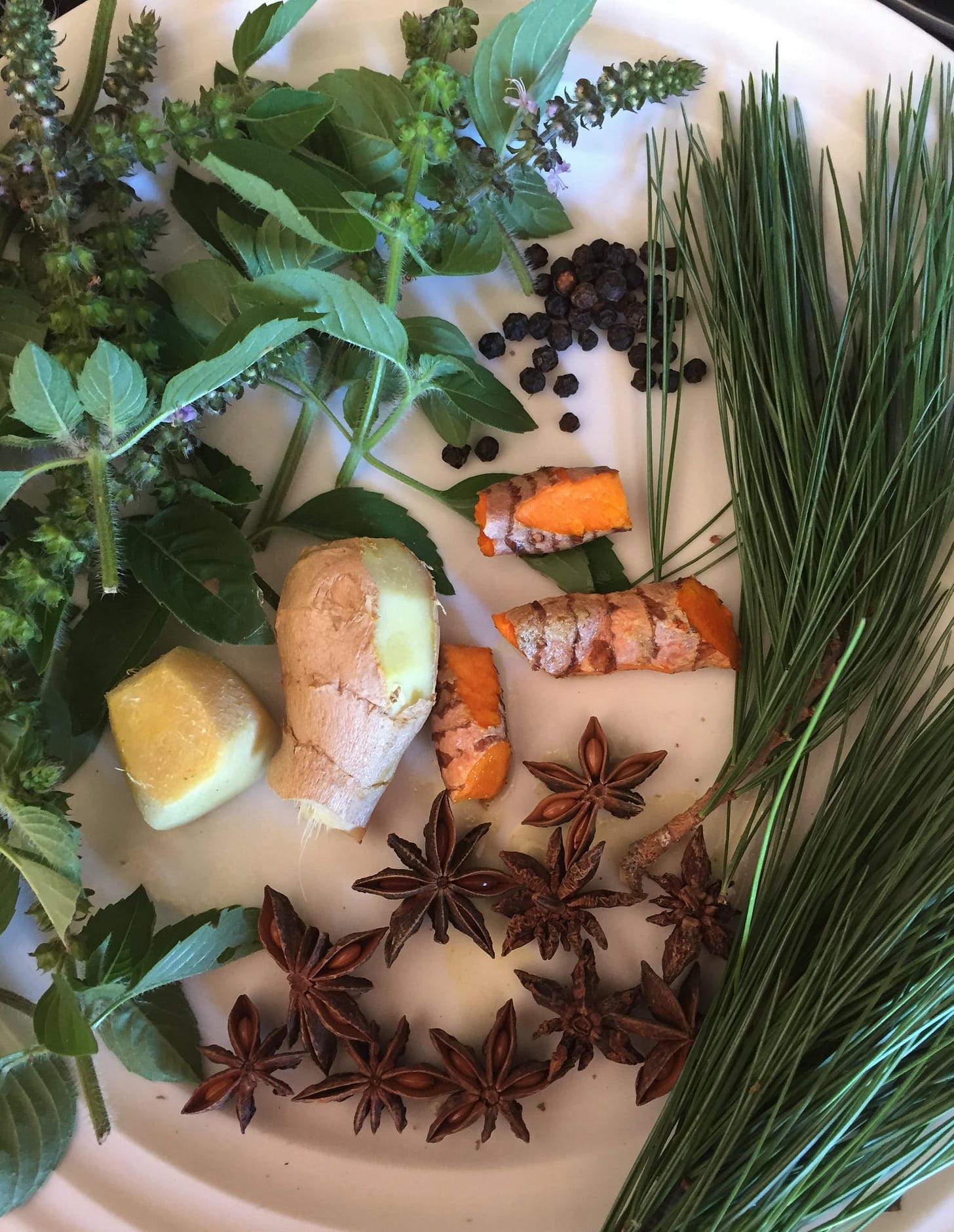
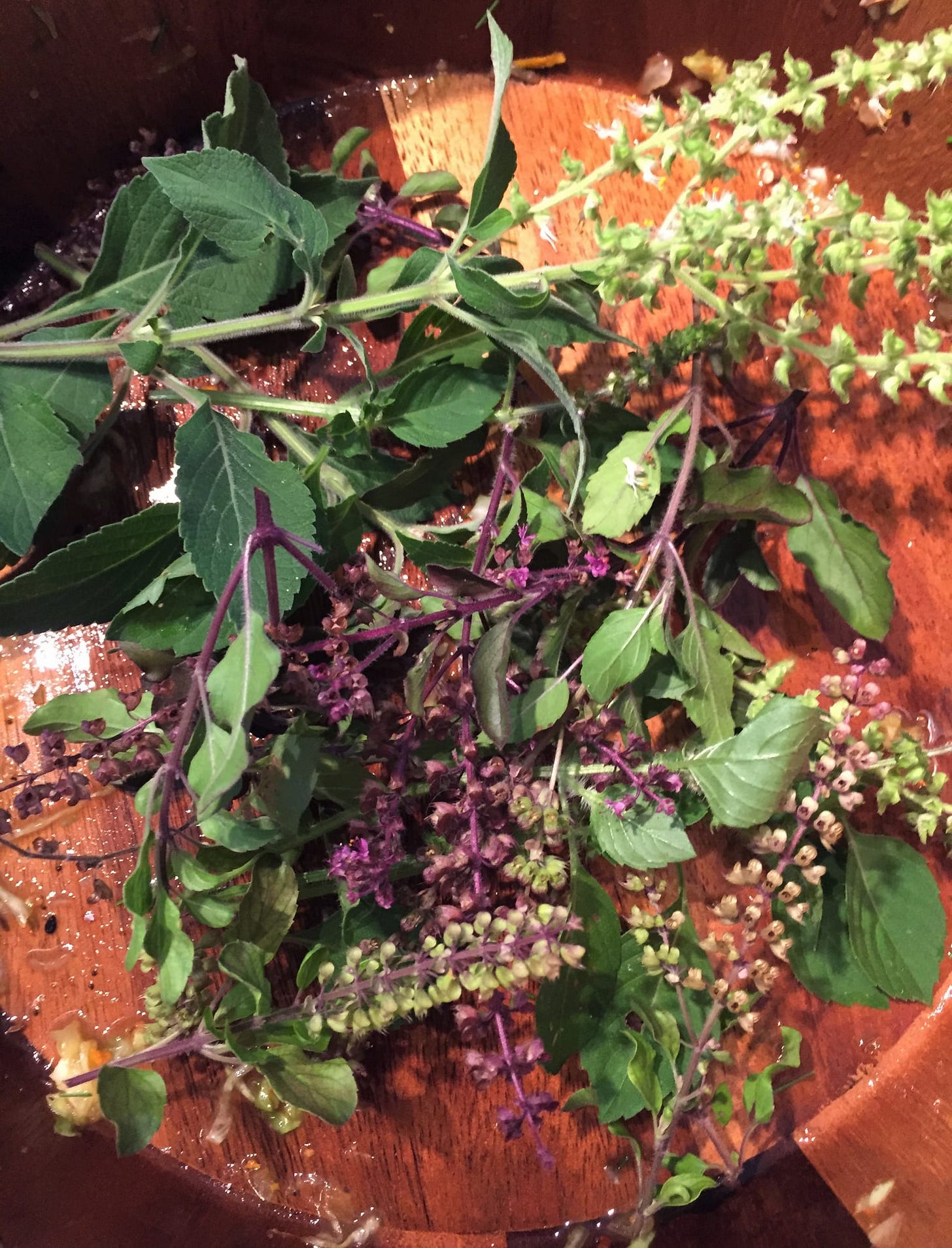

Other notable and delicious ways to enjoy Tulsi in your daily diet is adding some leaves/flowers to robust and/or brightly flavored soups or curries (such as Thai soups, Laotian recipes, Indian curries, Korean soups and hearty Miso soups).
Tulsi For The Skin
Tulsi is jam packed with antibacterial, anti-inflammatory, and antioxidant properties, that all work together to heal the skin.
The antiseptic properties of holy basil make it useful for topical applications, including for wounds, ulcers, challenging skin diseases like athlete’s foot and staph infections of the skin.
Ursolic acid, a major compound found in holy basil, is a carboxylic acid present in a wide variety of plants in the form of a free acid or an aglycone of triterpene saponines. It has been used to treat photoaged skin because it inhibits the appearance of wrinkles and age spots by restoring the skin’s collagen bundle structures and elasticity. Ursolic acid also blocks the inflammatory enzymes cyclooxygenase and lipoxygenase, as well as inhibits tumors (through the inhibition of MMP-2 and 9). Because of its wound-healing and antioxidant activities, holy basil may be useful in the management of abnormal healing conditions such as keloids and hypertrophic scars. Holy basil’s pain-relieving action is exerted both centrally as well as peripherally and involves an interplay between various neurotransmitter systems. Pre-clinical studies show that phytochemicals in holy basil—including eugenol, rosmarinic acid, apigenin, myretenal, luteolin, β-sitosterol, and carnosic acid—may prevent chemical-induced skin, liver, oral, and lung cancers. The protective effects include increasing antioxidant activity, altering gene expression, inducing apoptosis, and inhibiting angiogenesis and metastasis.
An aqueous extract of tulsi and its flavonoids, orientin and vicenin, appear to protect mice against radiation-induced sickness and mortality and to selectively protect normal tissues against the tumoricidal effects of radiation. Other phytochemicals like eugenol, rosmarinic acid, apigenin, and carnosic acid found in holy basil have also been shown to prevent radiation-induced DNA damage.
Tulsi essential oil has also been scientifically shown to be effective against selected microbial pathogens. There are more than fifty compounds that have been identified in Tulsi leaves, flower spikes, or essential oil, and three of these are directly responsible for this activity: camphor, eucalyptol, and eugenol. Since the bacteria S. aureus (including MRSA), P. aeruginosa, and E. coli are major pathogens causing skin and soft tissue infections, Tulsi essential oil has been studied and lauded for its value as a topical antimicrobial agent for the management of skin infections caused by these organisms.
I like to make a combined extract of Tulsi and several other powerful medicine plants (such as Cannabis, Lavender, Mint, Aloe Vera and Sage) and infuse into coconut oil to create powerful multipurpose topical medicines. One such topical formulation we make annually is something that includes all of the above ingredients (and more) which I call “𝗧𝗵𝗲 𝗦𝗮𝗰𝗿𝗲𝗱 𝗦𝗲𝘃𝗲𝗻 𝗦𝗮𝗹𝘃𝗲”. It is topical salve that can be applied to open wounds to disinfect (it can be used as a topical antiseptic, antibiotic and antifungal), provide localized pain relief (it can be used as an analgesic) and accelerate the healing process (it provides the epithelial cells the molecular building blocks required for accelerated rates of cellular regeneration) which means it is also helpful in diminishing the appearance of scar tissue. It is a salve can also be applied to sore muscles, joints and tendons to alleviate pain and provide anti inflammatory effects.
𝗧𝗵𝗲 𝗦𝗮𝗰𝗿𝗲𝗱 𝗦𝗲𝘃𝗲𝗻 𝗦𝗮𝗹𝘃𝗲
This is the most up to date version of my DIY topical medicines. I did my best to combine my knowledge of medicinal herbs with my permaculture design mindset so I could stack as many functions as possible. This topical salve is infused with the essence of 7 powerful healing herbs (and several other supporting ingredients) that are considered as a sacred…
References relating to Tulsi’s topical medicinal benefits:
-https://www.frontiersin.org/articles/10.3389/fmicb.2016.00681/full
- http://www.scienceasia.org/content/viewabstract.php?ms=2741&v=11&abst=1
- https://draxe.com/essential-oils/clove-oil-uses-benefits/
- https://www.ncbi.nlm.nih.gov/pmc/articles/PMC4296439/
- https://pubmed.ncbi.nlm.nih.gov/11595826/
- https://www.ncbi.nlm.nih.gov/pmc/articles/PMC3116524/
- https://pubmed.ncbi.nlm.nih.gov/10782484/
- S.K. Das, A. Chandra, S.S. Agarwal, N. Singh, N. (1983). Ocimum sanctum (Tulsi) in the treatment of viral encephalitis. The Antiseptic, pp.1-5.
- B. Vrinda and P. Uma Devi, “Radiation protection of human lymphocyte chromosomes in vitro by orientin and vicenin,” Mutation Research 498(1–2) (2001): 39–46 [FC]; R. S. Ubaid, K. M. Anantrao, J. B. Jaju, and M. Mateenuddin,
- “Effect of Ocimum sanctum (OS) leaf extract on hepatotoxicity induced by antitubercular drugs in rats,” Indian Journal of Physiology nd Pharmacology 47(4) (2003): 465–70.
- http://www.sciepub.com/reference/61289
- https://www.ijpsdr.com/index.php/ijpsdr/article/view/193
- F. L. Hakkim, C. G. Shankar, and S. Girija, “Chemical composition and antioxidant property of holy basil (Ocimum sanctum L.) leaves, stems, and inflorescence and their in vitro callus cultures,” Journal of Agricultural and Food Chemistry 55(22) (2007): 9109–17. [FC]
- https://pubmed.ncbi.nlm.nih.gov/17887944/
- Baliga MS , Jimmy R, Thilakchand KR, Sunitha V, Bhat NR, Saldanha E, Rao S, Rao P, Arora R, Palatty PL. Ocimum sanctum L (Holy Basil or Tulsi) and its phytochemicals in the prevention and treatment of cancer, Nutr Cancer. 2013;65 Suppl 1:26-35. doi: 10.1080/01635581.2013.785010.
- https://pubmed.ncbi.nlm.nih.gov/27072205/
- S. C. Kim, V. Magesh, S. J. Jeong, et al., “Ethanol extract of Ocimum sanctum exerts anti-metastatic activity through inactivation of matrix metalloproteinase-9 and enhancement of anti-oxidant enzymes,”Food and Chemical Toxicology 48(6) (2010): 1478–82. [FC]
- Ahmad, et al. “Ocimum sanctum attenuates oxidative damage.”
- https://pubmed.ncbi.nlm.nih.gov/15219842/
- Dharmani, et al., “Evaluation of anti-ulcerogenic and ulcer-healing properties.”
- https://pubmed.ncbi.nlm.nih.gov/17051736/
Tulsi In The Garden:
I have been noticing how the Temperate Tulsi (Ocimum africanum) aka “Holy Basil” blossoms are favored by native pollinators in our garden.
Tulsi is also fantastic for attracting beneficial insects, especially parasitoid wasps and solitary bees.
I wonder if this is due to the pollinators being able to derive medicinal benefits from some of the 54 medicinally active compounds that have been identified in Tulsi flower spikes? Perhaps they are getting trace amounts of camphor, eucalyptol and/or eugenol (or other medicinally active compounds) in the nectar and this is making them feel amazing, increase their resilience, energy levels and over all health? There are some people that believe this is indeed the case: https://peakd.com/naturalmedicine/@mountainjewel/dobeesselfmedicateonplantmedicine-zhhjai5dx2 ). I can speak from experience in my observing how the pollinators I watch in our garden seem particularly invigorated and happy as they forage the nectar on the flowers of this specific plant. I hope this helps them do their important work and live longer lifespans (in spite of all the chemical toxicity humans have introduced into their habitats).
But whether or not the pollinators foraging for nectar from our Tulsi plants are getting adaptogenic benefits for their immune system, anti-oxidant/essential oil fueled detoxification, supercharged metabolism and enhanced nervous system function (or just getting some good nectar as regular food) it is evident that Tulsi is a fantastic companion plant. I have noticed Tulsi has helps increase pollination rates and attracts beneficial predator insects like parasitoid wasps (solitary non nest building types) that control the numbers of things like caterpillars and aphids.
In particular I see a lot of cross over in the specific species of pollinators that prefer our goji berry blossoms and those that are frequenting our Tulsi blossoms (such as mason bees, sweat bees, cuckoo wasps, bumblebees, hover flies and carpenter bees) so I highly suggest companion planting these two highly nutritious, medicinal and beautiful plants together.
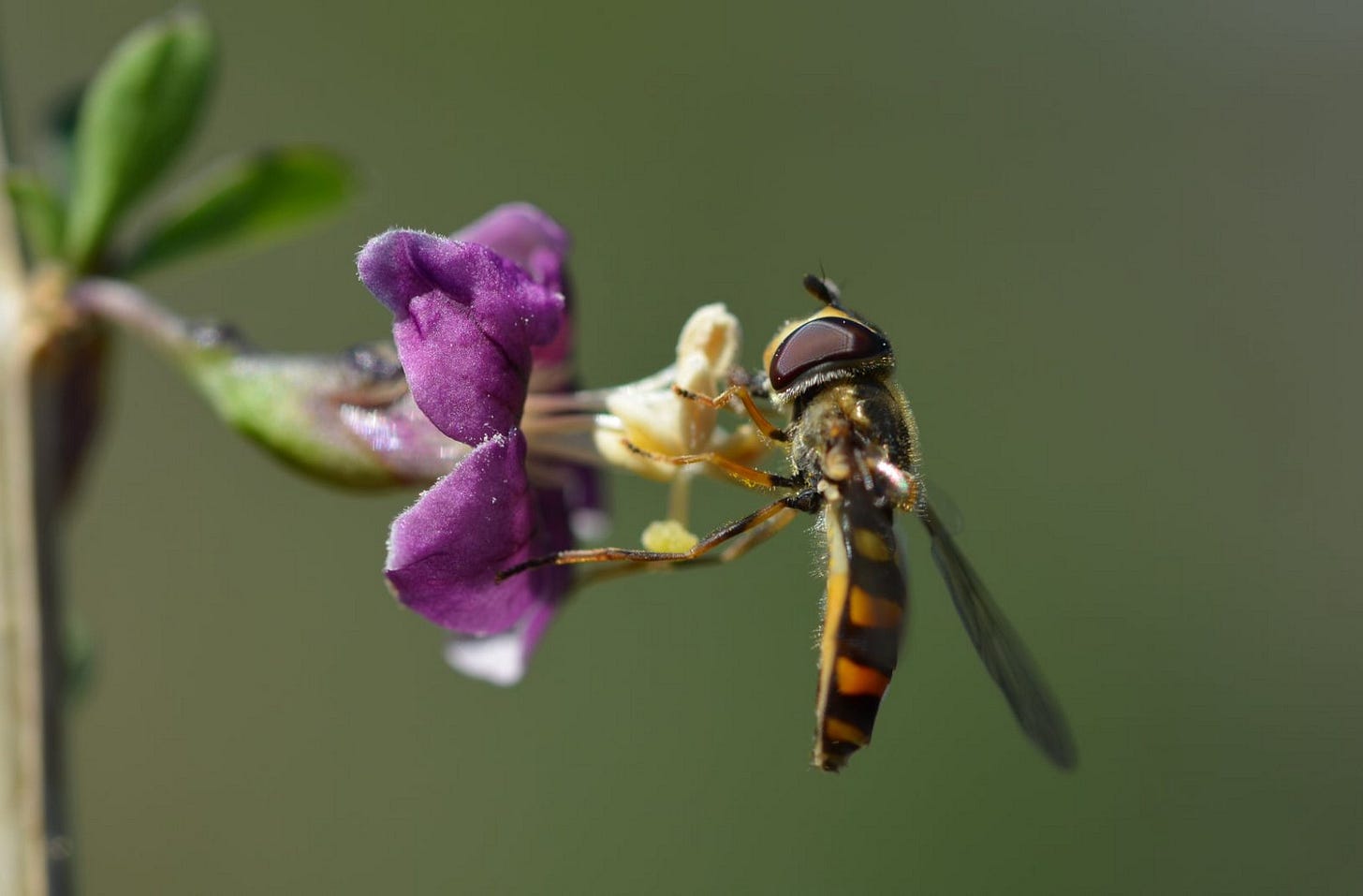
We got our original seeds from strictlymedicinalseeds.com and they were very high quality so if you are looking for seeds I suggest getting this package set that includes 5 different types so you can experiment with what works best in your garden.
I hope this will inspire you to try growing some of your own Tulsi at home. Wishing you all good health, longevity and many bountiful harvests.
I will be including tips for companion planting and additional info on other medicinal super herbs and spices in my upcoming gardening/recipe book.
You can learn more about my book and pre-order a copy through this link: recipesforreciprocity.com


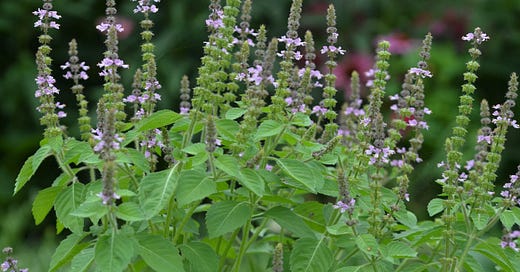



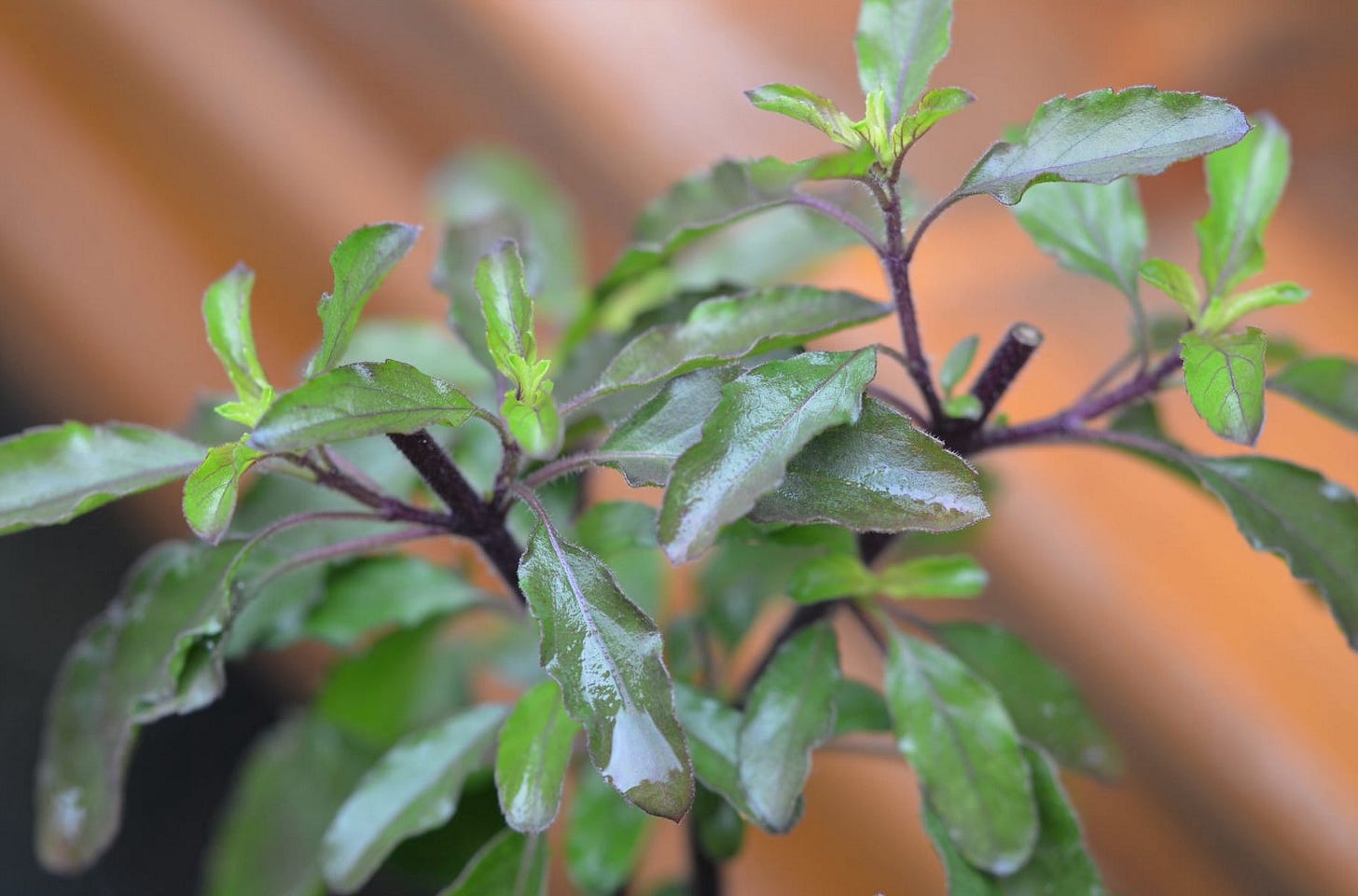
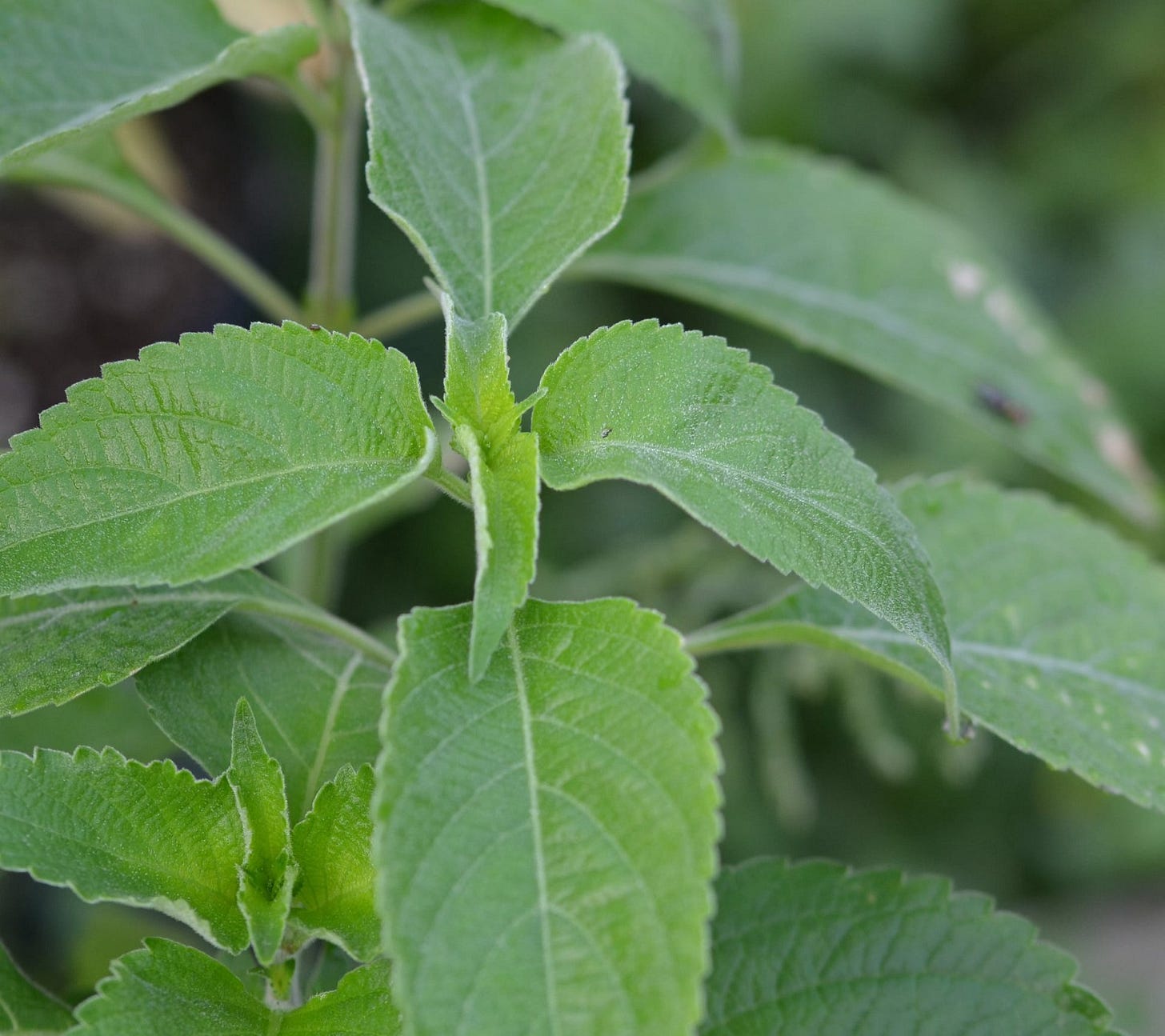

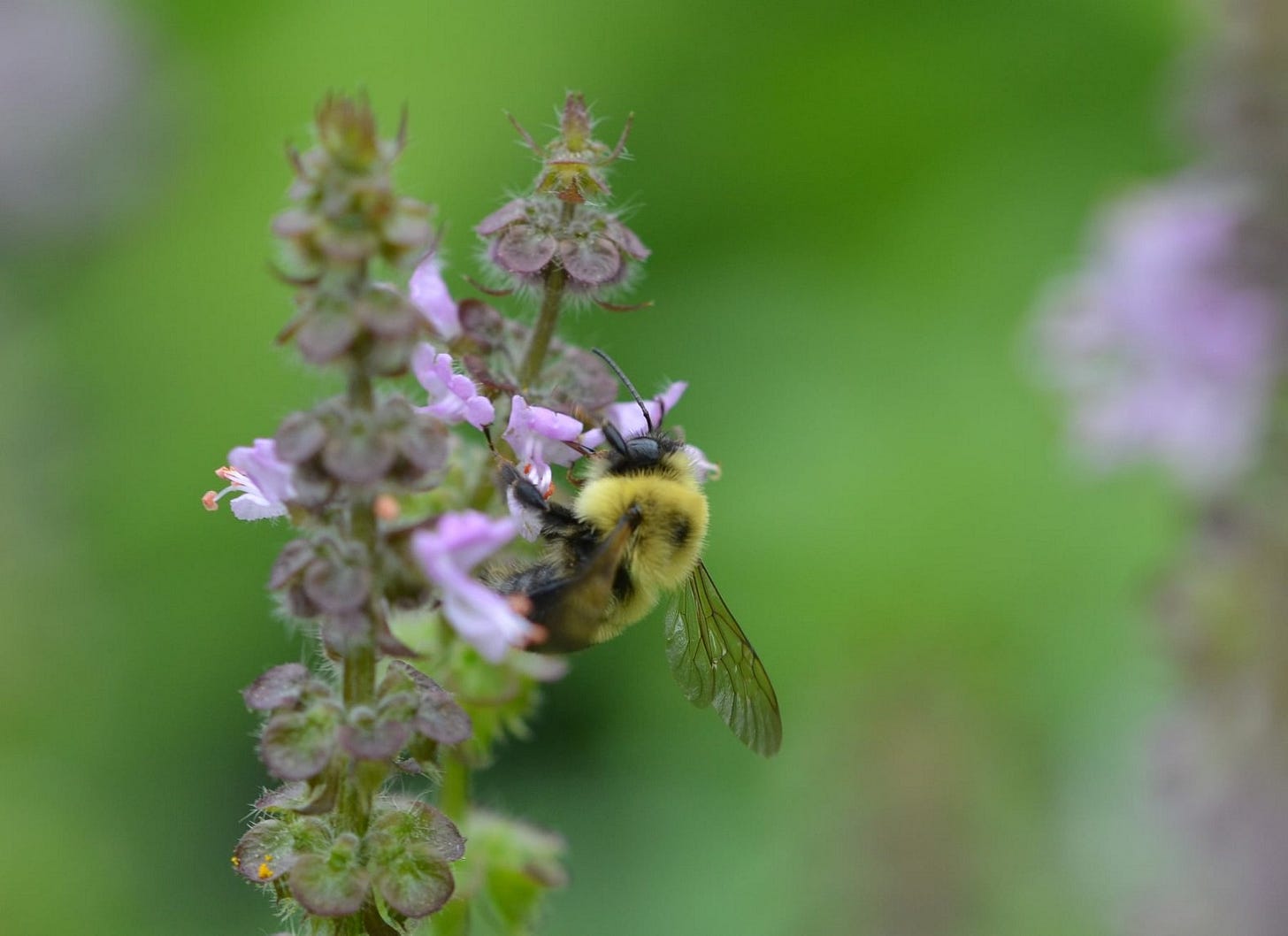
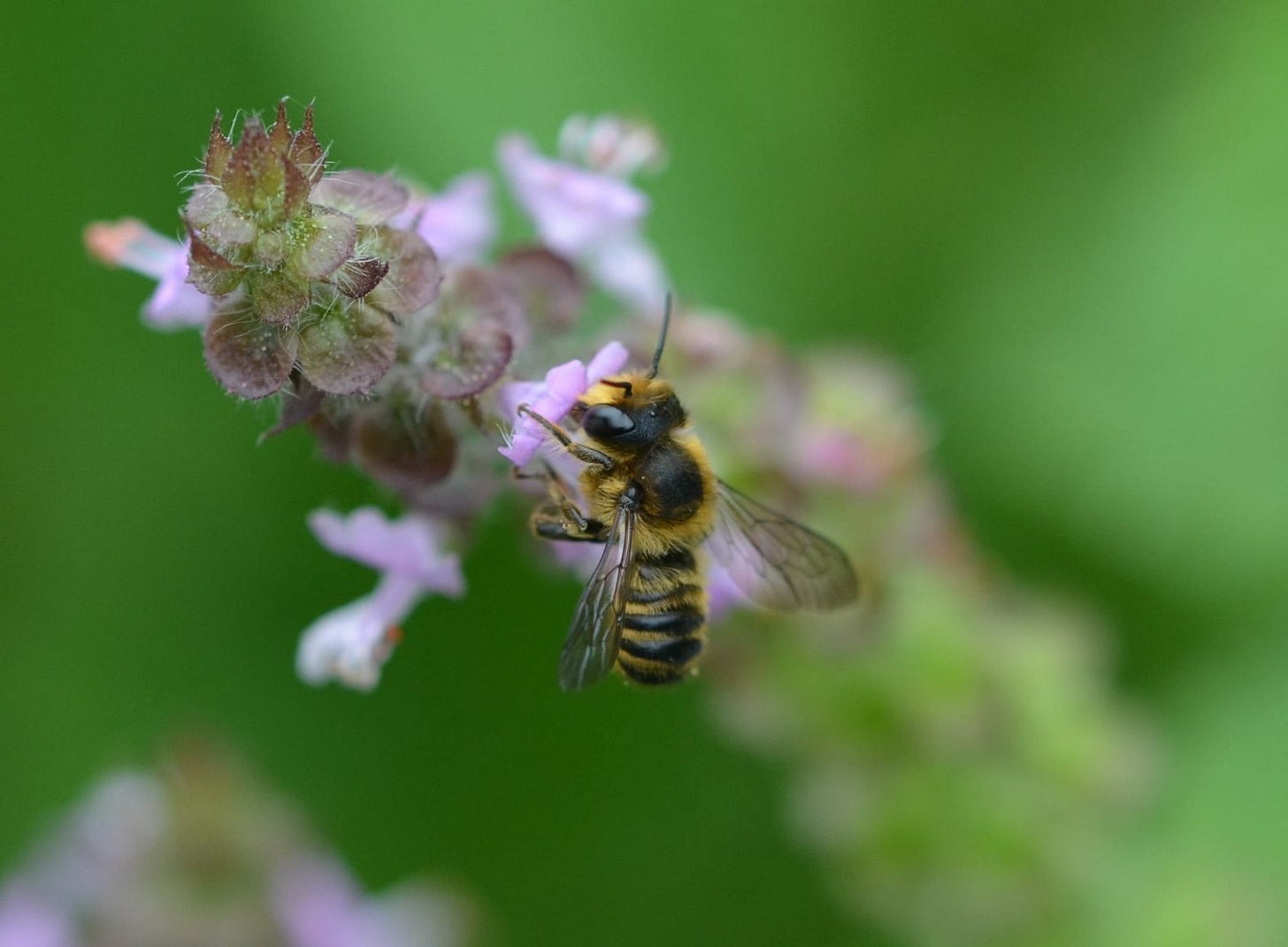
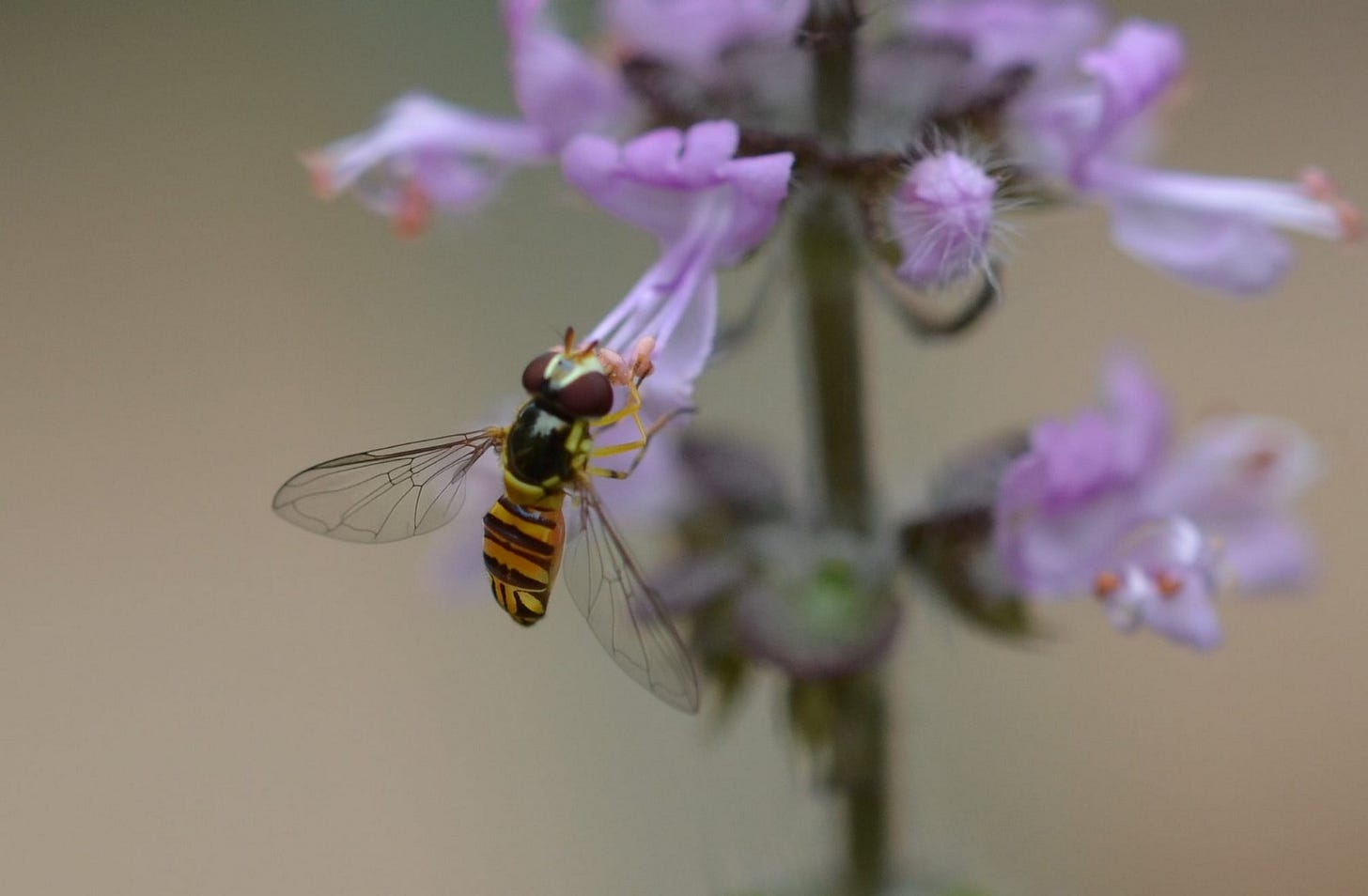
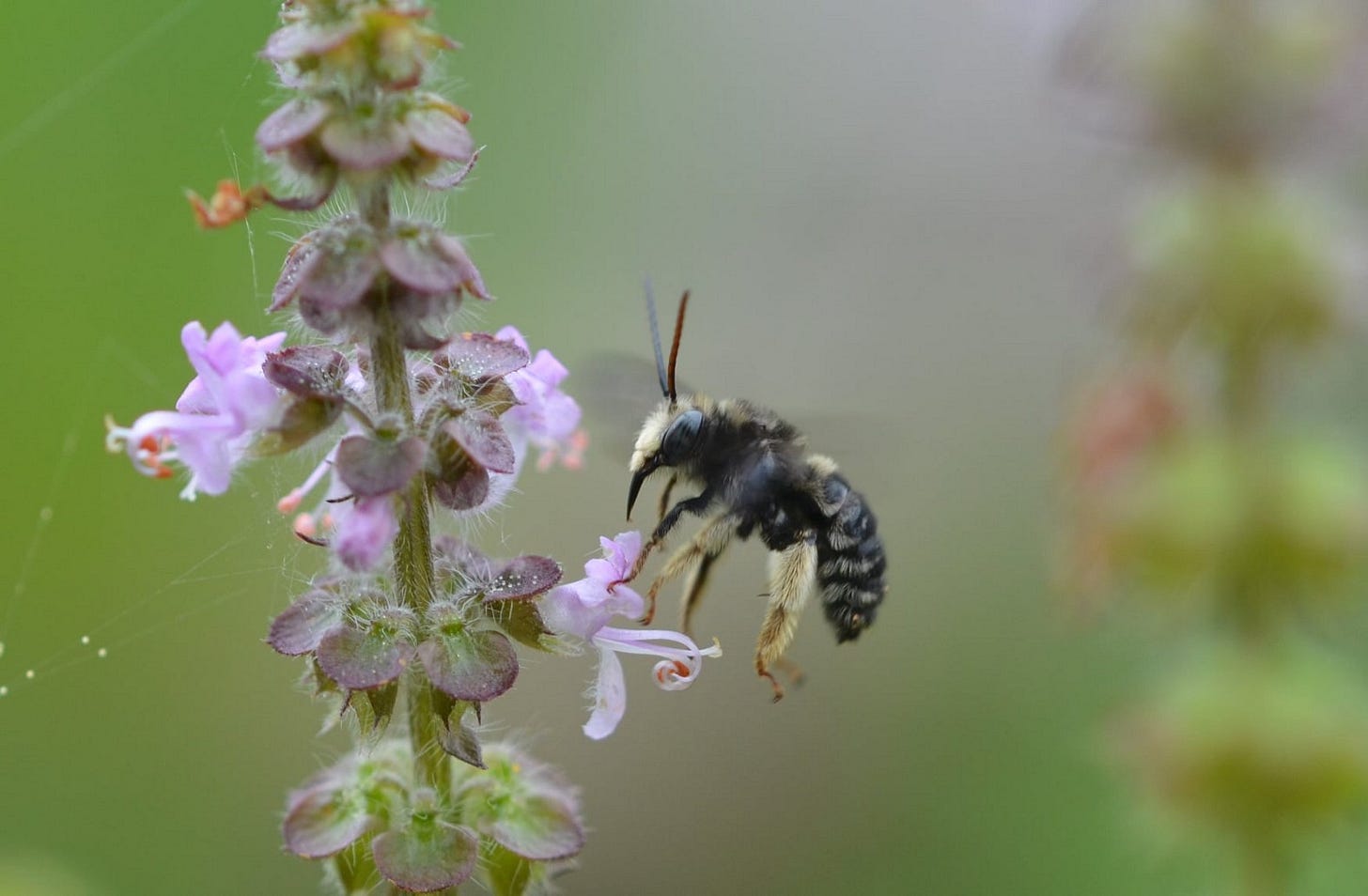
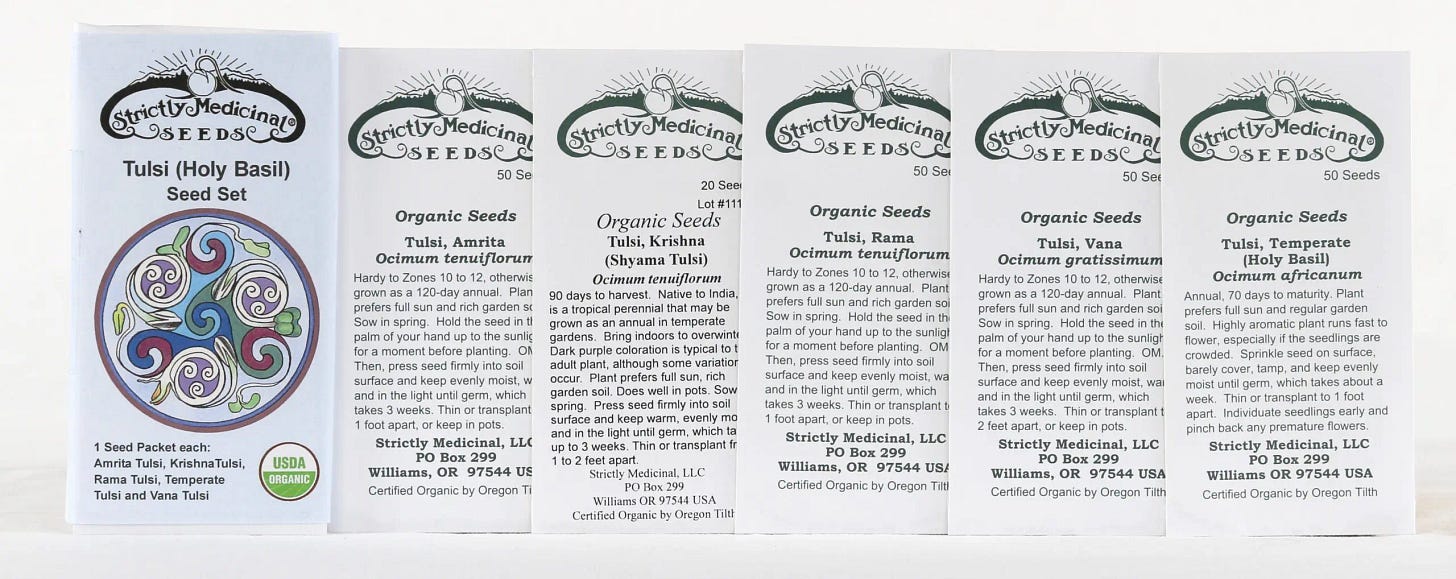
Gavin,
What would be the best way to preserve tulsi at the end of gardening season? Thanks!
The photographs are spectacular. :) Are you the photographer too?